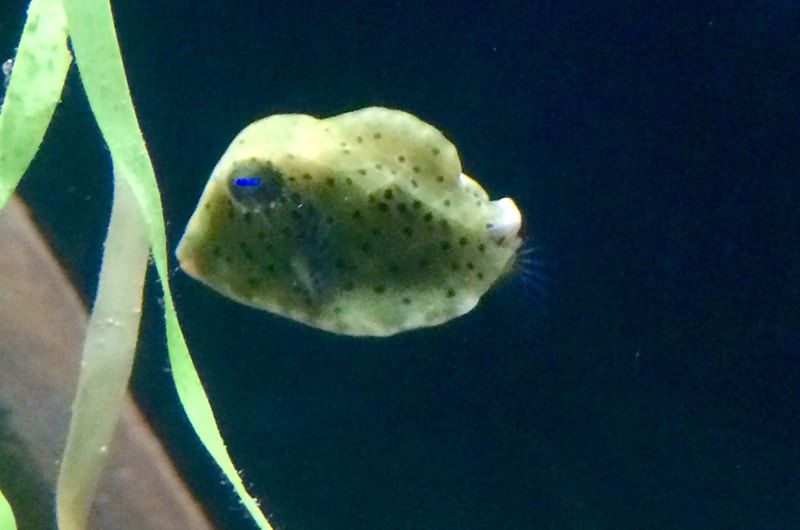~ by Katherine Brooks, Maria Mitchell Association ~

Coastal New England, especially Nantucket Island, receives a plethora of these orphaned fish in late summer. The tropical fish gather in eelgrass, moorings, and rocky coverings, which act as makeshift coral reefs. They adapt well to their new home, but the sad reality is that these fish cannot survive the drop in water temperature during the fall and winter months. Though this story sounds tragic, there is a happy ending for many of the fish. The protagonists of the story are the New England Aquarium of Boston and the Maria Mitchell Association of Nantucket that act as the heroes.
Currently the Maria Mitchell Aquarium houses four different types of tropical orphaned fish: buffalo trunkfish, permits, flying gurnard, and doctorfish tang. These fish were all caught near Madaket and will live out the rest of their lives at the Aquarium. Tropical fish are often brightly colored for camouflage or to attract a mate. The buffalo trunkfish (pictured) is the only one of its type at the aquarium. A tiny puffer-looking fish, with electric blue eyes, the buffalo trunk fish is kept in it’s own tank because of the fish’s lethal defense mechanism: when stressed out, the buffalo trunkfish will secrete a toxin that kills everything within its tank (except for those of its own species). The doctorfish tang has its own menacing story—named for its sharp scalpel like barbs at the base of its caudal fin, the doctor fish uses it for competition and defense. Permits have a plate-like grinder in the back of their mouths that aid the consumption of bivalves (or shellfish), which sounds like medieval torture, but is a practical tool integral to the fish’s survival. Although the tropical fish seem to be able to defend themselves against predators, they are unable to protect themselves against the forces of the Gulf Stream.
No two weeks at the Aquarium are ever the same; the tanks are seasonal and used for housing common to rare species (like the orphan tropical fish). Learn more fun facts about the plants and animals that line the beaches of Nantucket and join the Maria Mitchell Association on Marine Ecology Field Trips during the day or go on an adventurous Night Marine Ecology Walk and see how Nantucket’s beaches change between day and night. Sign up at the Aquarium on Washington Street or call 508-228-5387.
The MMA was founded in 1902 to preserve the legacy of Maria Mitchell and to promote her belief in learning-by-doing. An astronomer and natural scientist, as well as an educator, Maria Mitchell shot to worldwide fame when she discovered a comet in 1847. For her discovery, she was awarded a gold medal from the King of Denmark – the first American and first woman to receive the honor. She served as the Professor of Astronomy and Mathematics at Vassar College from 1865 until 1888. Today, the MMA operates two observatories, a natural science museum, an aquarium, and the birthplace of Maria Mitchell. The MMA conducts scientific research, leads classes and workshops for people of all ages year-round, and welcomes thousands of visitors to its museums and observatories. For details, visit www.mariamitchell.org.